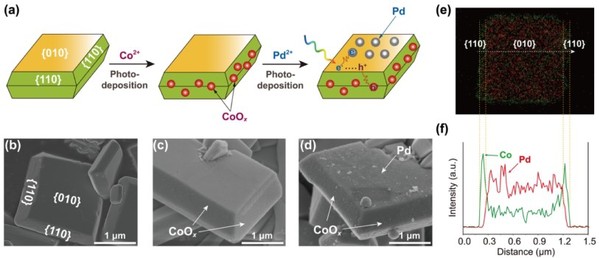Green synthesis of H2O2 using water, air, and sunlight
Harvesting solar fuels by artificial photosynthesis has great values in the global missions on tackling climate change and environmental pollutions. Among various artificial photosynthetic reactions, solar-driven water splitting for H2O2, an emerging liquid fuel as well as a green oxidant, are attracting growing interests. Recent studies on this topic have made significant progress, yet are mainly focused on using organic polymers. This set of photocatalysts is susceptible to potent oxidants (e.g. hydroxyl radical) that are inevitably formed during H2O2 generation.
Recently, a new study reports an inorganic Mo-doped faceted BiVO4 (Mo:BiVO4) system that is resistant to radical oxidation and exhibits a high overall H2O2 photosynthesis efficiency among inorganic photocatalysts, with an apparent quantum yield of 1.2% and a solar-to-chemical conversion efficiency of 0.29% at full spectrum, as well as an apparent quantum yield of 5.8% at 420 nm.
The study, led by the research group of Dr. CHU Chiheng from the Zhejiang University College of Environmental and Resource Sciences, was a collaboration between Zhejiang University, Chuo University,the University of Tokyo, Shinshu University, and Toyota Technological Institute. It was published in the journal Nature Communication entitled “Overall photosynthesis of H2O2 by an inorganic semiconductor”.

Facet-selective loading of CoOx and Pd cocatalysts on Mo:BiVO4
For the study, the researchers precisely tuned the surface-reaction kinetics and selectivity of Mo:BiVO4 by loading CoOx and Pd on {110} and {010} facets, respectively, at the nano-scale. Time-resolved spectroscopic investigations of photocarriers suggest that depositing select cocatalysts on distinct facet tailored the interfacial energetics between {110} and {010} facets and enhanced charge separation in Mo:BiVO4, therefore overcoming a key challenge in developing efficient inorganic photocatalysts.
“This not only creates a new record for H2O2 photosynthesis with inorganic semiconductor photocatalysts. Most importantly, the promising H2O2 generation efficiency achieved by delicate design of catalyst spatial and electronic structures may shed light on applying robust inorganic particulate photocatalysts to artificial photosynthesis,” Dr. Chu said.
To apply the technology at large-scale, the group plan to fabricate a photocatalyst panel. The device validation and performance test are being conducted in ongoing work.